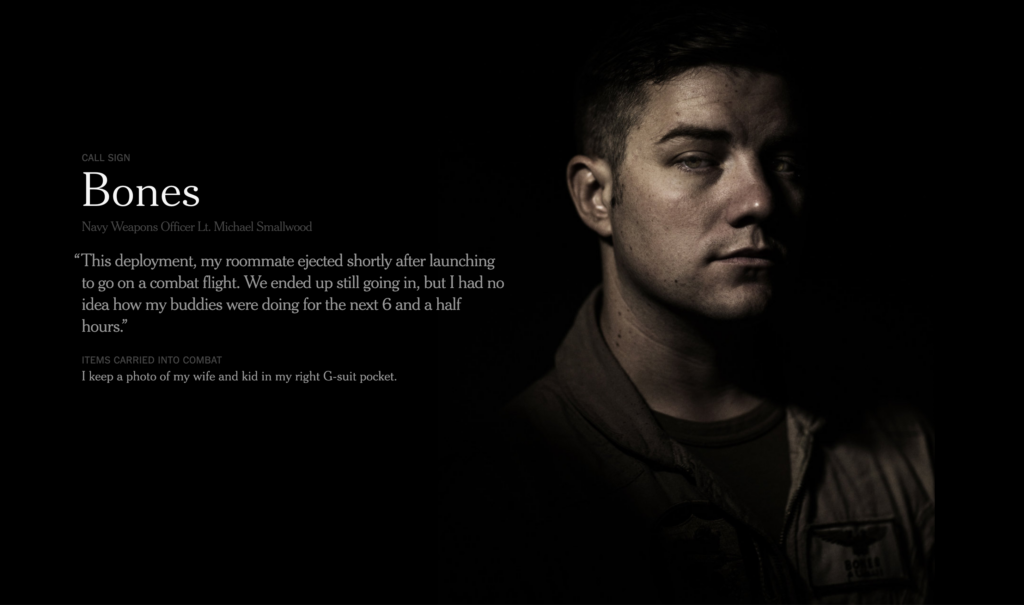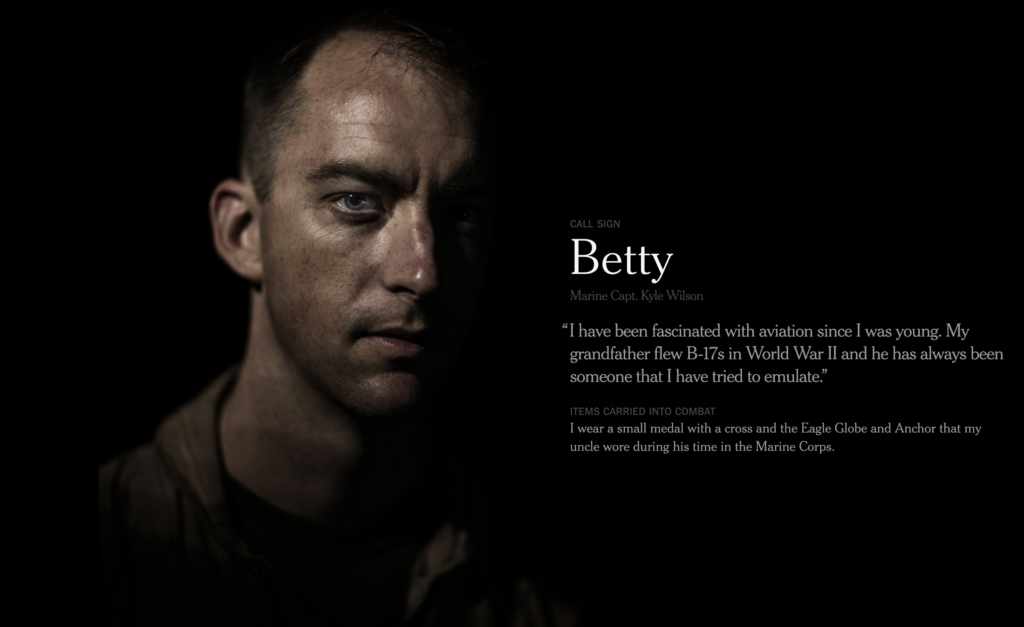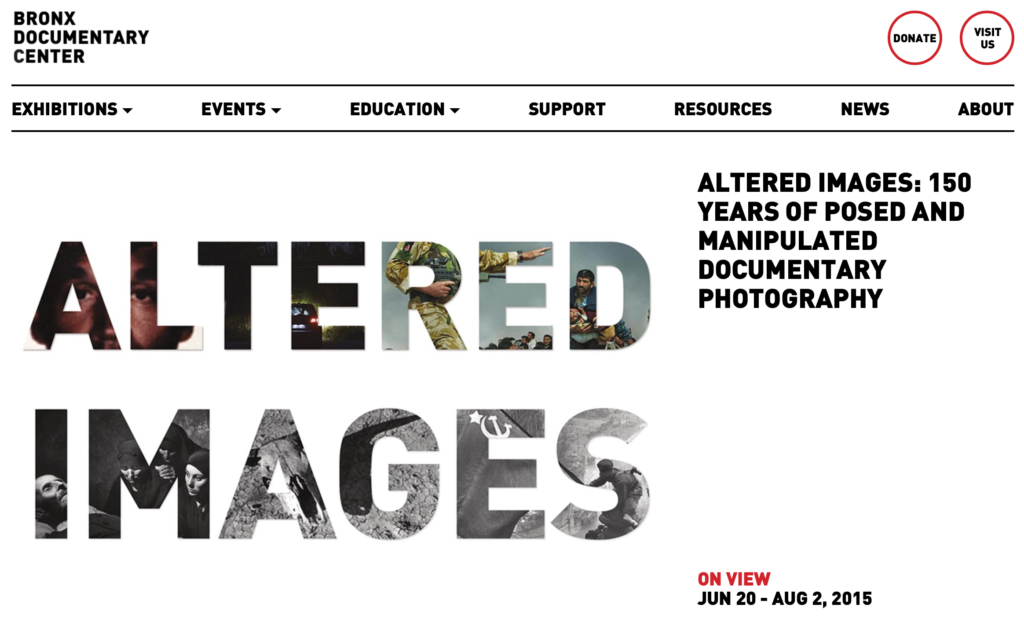The New York Times ran a well-produced piece called “The Pilots Fighting ISIS.”

We learn that two reporters for the New York Times, Helene Cooper and Adam Ferguson, were sent “Aboard the U.S.S. Theodore Roosevelt in the Persian Gulf.” Embedded with US military forces on an aircraft carrier battle group in the middle of the Persian Gulf, where access can only be achieved through careful negotiations and agreements between the highest levels of military command and the highest levels of the New York Times’s corporate command, there was no chance in hell that what the two reporters would come back with would be anything less than propaganda. That is what they produced.
Complete with a series of ‘beautifully’ and ‘aesthetically’ produced portraits of…er….all white, blue-eyed, true-American looking boys in ‘combat’ great, by the otherwise talented Adam Ferguson. With cute names like ‘Pickle’ and ‘Bones and statements that reflect their ‘family’ values – one pilot remembers to take his wedding ring with him when he flies, another a photo of his wife and kids, another carries an “Eagle Globe and Anchor that my uncle wore during his time in the Marine Corps.”
This is emotional stuff. Scripted and beautifully produced with a quality that a Hollywood production team would envy. This is bracing stuff. For a minute, I was sure I was looking at ‘Sponsored Content’.

I was initially amused that the US military had to spend so much money to buy page space in one of the most coveted advertisement publications in the USA. And then I realised that it wasn’t paid space at all. Nope. The New York Times paid the US military to produce this blatant piece of propaganda-thinly-veiled-as-journalism to get its staff aboard the ship, entrap them there at the mercy of the military, and ask them to write and photograph fluff nonsense, which would then be further funded with heavy investment in production values and people.
The New York Times spent serious funds, resources, and time to produce this rubbish.
This is a journalism publication that is now in the business of producing military propaganda and doing so in ways that help you forget that you are speaking about a belligerent nation in an ongoing military conflict that is a direct result of a previously failed military invasion, occupation and ongoing despot-democracy.
Even more dismaying is that nothing happens in the article, i.e. it is about nothing. It serves no purpose. It has no reason to exist other than to act as a mouthpiece for war and the military. This is truly a saddening new low for a publication that until now has been at least pretending it is trying to do genuine reporting from America’s war zones.
The entire piece attempts nothing at a historical background as to why we are even on this ship, or because of whose and what infantile and immoral policies an organisation like ISIS may have emerged from, and how we have spent trillions of dollars repeatedly dropping bombs in the hope of ‘disciplining’ the ‘damn A-rabs’, and despite repeated failures and pathetic defeats, we seem to have no other ideas but to drop more bombs.
Ironically, or perhaps intentionally, as Nina Berman pointed out in personal communication, this piece of fluff emerged just a day after the same New York Times revealed that Centcom analysts had been caught falsifying intelligence data to make it look like American bombing campaigns were more effective than they were. The New York Times reported that the analysts at the centre of the investigation allege that their superiors within Centcom’s intelligence operation changed conclusions about several topics, including the readiness of Iraqi security forces and the success of the bombing campaign in Iraq and Syria. [Mark Mazzetti and Mark Apuzzo, “Analyst Detail Claims That Reports on ISIS Were Distorted,” New York Times, September 16, 2015].
As usual, the relationship between the New York Times and the US government is anything but adversarial. Photojournalists continue to avoid confronting this issue, i.e. are photojournalists hired to work for publications deeply implicated in acts of government manipulation, lies and obfuscation, producing photojournalism?
Can anyone look at this piece – these beautiful images, and tell me with a straight face that this is journalism, let alone photojournalism? Would such a story be taken seriously had it turned up in the pages of a Chinese daily or even a Latin American one? Would any photojournalist of repute agree to produce such a piece had it been commissioned by the government of Egypt or, let’s say, Iran? Moreover, would they not have been challenged and questioned over their choices and asked to provide some explanations for their collisions?
For after all, here we have a publication that is well known to have not only collaborated in spreading the lies about Iraqi WMDs but, despite this, has continued to provide its pages for American military and political propaganda and rumours, even going so far as to ‘protect’ political insiders by offering them ‘anonymity’ – an act once reserved for those risking their lives and careers to reveal wrongdoing, but now on offer to any hack who has been told to spread government lies and misinformation.
With the help of compliant reporters, such as two friends on the aircraft carrier, the US reporters were selling a product called American War. And this has always been the intention. US media outlets have increasingly behaved as political and military establishment product placement and services promotional outlets.
“By the first Gulf War,” Mark Herold reminds us, “reporters were confined to pools, and the Pentagon distributed video-game-like footage to TV channels extolling the precision of U.S. weaponry.” Professional marketing and advertising professionals were bought to help sell the war to the US public. The PR firm Rendon Group1 was brought in. Charlotte Beers, the former chairperson of both advertising giants J. Walter Thompson and Ogilvy & Mather, was hired, and the State Department’s Under Secretary of State for Public Diplomacy post was created for her benefit. Beers was no ordinary marketing executive.
According to Colin Powell, then the US Secretary of State, she was among the world’s “greatest advertising experts.” Only such a person can help transform the prosecution of a genocidal war into the slogan of “selling democracy.” [ Mark Herold, “War as an ‘Edsel’: the Marketing and Consumption of Modern American Wars,” Keynote Address at “Teaching Peace,” a conference for New Hampshire teachers, activists, researchers, and students, held at the Oyster River High School, Durham, New Hampshire, Saturday, April 9, 2005.].
Democracy is sold abroad, and war is sold at home.
But while the battle for minds abroad led by Beers and Rendon fared poorly in Muslim lands, the war on the home front to persuade the American public has succeeded eminently. The Bush Administration worked hard to encourage and benefit from a compliant mainstream domestic corporate media – led by Rupert Murdoch’s Fox News, CNN, the Clear Channel radio network, radio talk shows, and major dailies like the New York Times, the Los Angeles Times, and The Washington Post and journals like Rupert Murdoch’s Weekly Standard – which served as giant megaphones of State Department and Pentagon positions on the Bush wars.
Clear Channel, the largest owner of radio stations in the country, scrapped any pretence of objectivity with its sponsorship of pro-war rallies in major cities throughout the U.S. The mainstream media bosses recognized – led by CNN’s coverage of Iraq in 1991 – that media flag-waving, fabricated personal story heroics, action-movie-like storytelling, and techno reporting could boost TV ratings and profits.
The depths to which journalism and its bed-mate, photojournalism, has collapsed is unbelievable. We are not even trying anymore. The machines, institutions, prejudices, political stupidities and outright lies that led us into this fine, fine mess in the region are re-cast, re-painted, re-furbished, and re-sold on the pages of the New York Times.
The community of photojournalists are discussing Instagram, photoshop aesthetics, and other such trivia not worthy of more than a minute or two of discussion, and yet absolutely silent about the deepening collusions between the state and media and the easy means by which propaganda has become reporting. From World Press Photo (WPP) to Picture of the Year International (POYi), there is absolute silence about blatant propaganda like this. Many stories produced from US military embeds have gone on to win “journalism” awards at these competitions!
We have chosen to remain silent about the entire enterprise, hoping no one will notice. Even Visa Pour L’image has refused to utter a statement and gleefully displayed and awarded ‘photojournalism’ based on photographers deeply embedded with French forces. There was no mention of the growing nature of these embedding / obfuscating developments in the Bronx Centre’s “Altered Images” exhibition, which went so far as to scold certain photographers for their methods but said nothing about entire editorial departments at major news publications. The organizer of that exhibition himself had long been an embedded photojournalist with the US military. Irony has died in the USA.

Do we not think we should discuss the implications of close collusions of journalism and political power for photojournalism and our ideas for acceptable editorial imagery?
When did we set the bar so low?
I remain flabbergasted that our community has allowed it to be this simple. To allow editors to make these choices, to design these ideas, to produce and disseminate them, all the while saying nothing to challenge their approach, question their judgement, and demand that they reconsider. I don’t expect people to refuse to work for these publications, but I can’t believe no one is questioning what is happening.
Indeed, at the New York Times, this line between propaganda and reporting has been crossed too often and with too much transparency. A newspaper with a vast global readership and a powerful influence on American society, I would imagine that it would be – if it wants to claim that it is a journalism outlet, even more, determined to maintain a clear line of division between itself and power and to produce works (editorial and photographic) that ensure readers understand that it is serving public and not power interests.
The editors – editorial and photographic, at the New York Times seem to have forgotten their job.
Or they are doing it well.